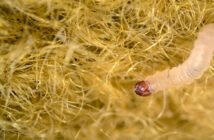Controlling rodents is no easy task. Every pest controller will know just how many elements there are to consider, from managing environmental factors to picking the right rodenticide and baiting strategy for the job. But with several baiting strategies and rodenticides available on the market, it can be difficult to decide which is the most effective approach.
Here, Laurence Barnard, country business manager, Professional and Specialty Solutions for BASF Pest Control shares an overview of the options available:
Before even reaching for a rodenticide, it’s important that any individual using a chemical control method follows appropriate best practice. That means carrying out thorough site assessments, environmental management and proofing, and always following label instructions and legislation.
While this might seem obvious, it’s essential to ensuring an effective rodent control programme while minimising the risk to non-target species.
Once the required steps have been completed, it’s time to pick your product and apply the best baiting strategy. In recent years, the types of rodenticides available and therefore the way we use them have developed drastically, but this “back to basics” guide should help give users a useful overview:
Pulse baiting
Pulse baiting is used for single-feed, anticoagulant rodenticides. Typically, the products used for this technique are highly toxic for rapid control, such as Storm Secure & Storm Ultra Secure, meaning a rat or mouse can eat a fatal amount in a single feed.
The typical pulse baiting programme using a rodenticide like Storm Ultra Secure is as follows;
Pulse 1, day 1
The first rodents (dominants) feed on the bait and start to feel the toxic effects on or around days 3-4.
Pulse 2, day 4
Targets other individuals (sub-dominants) in the infestation, which then start to feel the toxic effects on or around days 7 -8
Pulse 3, day 7
Targets non-dominants in the infestation, which then start to feel the toxic effects on or around days 10-11
Pulse 4, day 14
Targets the remaining infestation. This pulse may not be required as the infestation may be controlled.
Pulse 5, day 21
Targets the remaining infestation. This pulse may not be required as the infestation may be controlled.
A significant advantage of this approach is that pest controllers need less bait per rodent to deliver a lethal dose, meaning reduced upfront costs and reduced wastage. Further down the line, if applied properly, can mean that there is also less rodenticide in the local environment, which could reduce the risk of non-target primary poisoning and secondary poisoning throughout the wildlife food chain.
However, this type of baiting is only suitable for use in and around buildings, over a very short period of time, limiting its suitability for certain sites and issues.
It is also essential that users search for dead and dying rodents during baiting period to minimise the risk of secondary poisoning due to the accumulative effect of anticoagulants.
Speed baiting
Speed baiting is a new strategy enabled only by the cholecalciferol active used in Selontra that makes complete control possible in as few as seven days. This highly effective approach results in a “stop-feed” effect, whereby rodents stop feeding and moving around a site in just 24 hours, and death then occurs two to five days after consuming a lethal dose.
This offers multiple benefits. Firstly, the spread of disease and contamination is immediately reduced, as rodents stop moving around and eating after a lethal dose is consumed. Its high potency means significantly less bait is required in the first place, and there is little to no need for multiple follow ups, saving precious time and money.
What’s more, the active ingredient is readily metabolised by rodents and it non-bioaccumulative, reducing the risk of secondary poisoning. Significantly, there is no known resistance so control is quick and effective on colonies even in areas of known rodenticide resistance.
To implement a 7-2-7 speed baiting approach, lay seven blocks of Selontra per station on day one if targeting rats, and two blocks against mice, as per the guidance on the label. On day two, revisit baiting stations to replenish the blocks that have been consumed – thanks to its high palatability, it is most likely that you will observe complete uptake. By day seven, you should have full control over the infestation – including resistant rats.
Saturation baiting
Also known as surplus baiting, saturation baiting is used with multi-feed anticoagulant baits and requires the rodent to consume the rodenticide multiple times to receive a lethal dose. These baits are generally lower in potency and therefore a large quantity is needed to have the desired effect.
While this approach can result in a reduction in rodent population by providing an abundant supply of bait, it’s important to weigh up the environmental drawbacks when it comes to using some second-generation anticoagulants.
Although these baits are less potent than others, a larger quantity is required for the active ingredient to take effect. This is problematic for two reasons – firstly, there is a higher risk of primary poisoning due to more rodenticides being available in the environment, and secondly, the cumulative effect increases the risk of secondary poisoning if a rodent body is consumed by non-target species. Importantly, many rodents have also developed resistance to actives such as difenacoum, potentially risking the spread of so-called “super rats” aka resistant rats, in the area. Because of these issues, this approach is now less commonly preferred.
Whichever type of bait and baiting strategy a pest controller chooses, it’s vital that the benefits and drawbacks of each approach are considered against the environment and infestation to ensure the best approach is implemented.”




